VESNIANKY
Easter Feast
Dating to pre-Christian times, and now for over a thousand years
of Christianity, spring is greeted in Ukraine through joyful songs,
games and ceremonial round dances known as "Vennianky" and "Hahilky". Vesnianky
dating back to Ukrainian pagan times, in the fourth century A.D. or earlier
express the gentle ancestors of today's free Ukrainians who live in harmony
with nature and feel the great joy of spring. Vesnianky express this joy by
the creation of songs, dances, and games which imitate and celebrate nature,
and are still performed today at the end of the forty-day Lenten period before
Orthodox Easter which greets - "Velykden - The Great Day", and sometimes
continue until the following 'green feasts'.
Because it is known that Christ was crucified after
Passover, the date for Easter falls after Passover and on the fourteenth day
of Nisan (the first month of the Jewish ecclesiastical year and around the
vernal equinox) which is a fixed date in the Jewish lunar calendar.
Currently, churches using the Gregorian calendar (13 days earlier than the
Orthodox Julian calendar) calculate Easter as the first Sunday after the
full moon that comes on or after the vernal equinox (March 21). Easter
therefore can fall within a 35 day period between March 22nd and April 25th,
inclusive. Churches using the Julian calendar, but through the different
method of calculation may celebrate Easter or Velykden anywhere from one to
five days later.
The author of the DISK later explains in more detail
sophisticated seasonal traditions that arise between the period of March 1st to
May 31st.
Vesnianky (or spring songs) are commonly performed on
Easter Day by young girls at the forest edge or in the open forest, on the bank of rivers,
in the village square or in the churchyard near the cemetery. Song and
movement are combined in many ways, sometimes as two-part choral groups,
sometimes as synchronized round movements combined with song, and their
themes are mostly concerned with welcoming the sun, the burial of winter,
and calling upon the forces of nature. The young maidens are dressed in
a lightly embroidered chemise, a brightly colored
skirt, and wear garlands of spring flowers on their heads. Usually the girls
form a circle— symbolizing the
sun—performing round dances while singing spring songs.

Vocal tradition and polyphony
As in Ukrainian art, Ukraine's vocal traditions also exist within a great sphere of diversity. The origin, age and level of development of
songs can be determined on the basis of the theme, the literary style and the rhythmic
and melodic structures. Within Europe, folk polyphony exists in Ukraine, Georgia, Russia,
and in isolated areas in the Mediterranean (Corsica, Sardinia and inland Spain). The
tradition of singing in Ukraine has no comparison to any other choral tradition,
except for certain areas of southern Russia.
Solo and choral singing is practiced in the main: some songs are
sung by a single male or female singer; other are sung by choirs exclusively. The melody line in solo singing is mostly
characterized by it's greater liveliness and richer melismata.
A frequent and popular type of song is one in
which the beginning of the verse is sung by one or two singers (called
zaspiv,
introductory singing), and the rest of the verse or the refrain is then sung by the choir (called
pryspiv).
Choral singing in western Ukraine is performed in
unison, while two-part singing is mostly practiced in the eastern regions. The latter is
characterized by a higher leading-voice and a sub-voice. Sometimes a middle melody line
develops from these, resulting in three-part singing. By singing in octaves, a mixed choir
generates a larger power of separate voices, but the basis always remains two-part
singing. More typical for Ukrainian two-part singing uses the voice in parallel thirds,
sometimes changing into fifths or octaves. Apart from the thirds, fifths, and octaves,
that form the basic harmonies, other intervals may occur in choral singing, like added
'passing through' tones (passages through main melody and corresponding harmonies) and
assisting sounds for the melody, as well as those that are generated by the performers
through variations on the melody. This style of singing is called ‘polyphony of
sub-voices’, or ‘variant-polyphony’.
Three-part and four-part singing – following
homophonous harmonies – also occur in Ukraine. These are a later development and are
connected to melodies that have their origin in the cities, rather than in the
countryside and villages.
Musical Instruments
Bandura - Ukraine's national instrument
bandura is a plucked instrument which is related to
the medieval psaltery and to the Russian husli types, though its form is entirely
different. The bandura is a chromatic, harp-like hybrid instrument with forty or more melody
strings and ten to thirteen unfretted bass strings on the neck. It has an oval, flat body.
The body is made out of a hollowed log, which is rounded off. The table is oval or
pear-shaped. The neck is relatively short. Originally it used to be placed in the middle,
but in more recent times it was moved to the right. Generally handmade
instruments have no more than thirty strings, whereas the modern mass-produced models can
have up to sixty strings. 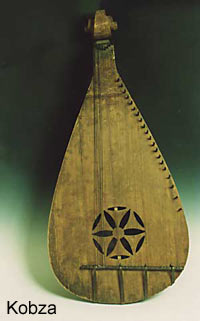
The bass-strings are played with the left hand and the melody
strings with the fingers of the right hand. The bandura is held in the
lap almost vertically in front of the chest. The bandura originated
in Ukraine and developed two different schools of playing and instrumental
styles: the Kiyivan and the
Kharkiv schools. The bandura does not appear in any other world cultures. The bandura is an instrument
that can accompany ones own or group singing or for be used for performance of pure musical pieces. There are different
traditional tunings. The first six strings, called bunty and pidbasky
(bass
strings), pass over the neck and the tuning is D-G-A-d-g-a. The melody strings, called prystrunky
(short strings) give a diatonic scale, with a b flat in both octaves, whereas the
deepest note is d. The right hand plucks the melody strings. The left hand plucks the
bass strings and sometimes also the nearest melody strings.
Experts cannot agree on the bandura's exact origin. The predecessor
to the bandura
was the kobza, a more simple but otherwise similar instrument, with less bass-and melody
strings. A kind of lute still played nowadays in Ukraine and in Rumania/Moldavia
also bears the name kobza, but most probably only the short neck and the name are derived
from the old kobza. The part with the melody strings of the kobza/bandura could be
interpreted as stemming from the old east-Slavonic husli. The kobzars (kobza players and
singers) played an important role in the Ukrainian fight for freedom and the uprisings
against the feudal lords. Bandurists existed from the 16th to the 19th
century; they were generally blind and with the aid of their
horses travelled throughout Ukraine as wandering minstrels, singing songs
known as Dumy, which were songs based on heroic Cossack deeds and free
spirit, which united the bandurists into a kind of brotherhood and musical guild.
Bayan - button accordion with a keyboard.
 Bubon (tambourine) - a round tambourine (frame
drum), with skin on one side mounted with five pairs of metal discs and a few small bells.
The tambourine is beaten with a short and thick stick, played in the central and eastern regions
of the Ukraine. Bubon (tambourine) - a round tambourine (frame
drum), with skin on one side mounted with five pairs of metal discs and a few small bells.
The tambourine is beaten with a short and thick stick, played in the central and eastern regions
of the Ukraine.
Bukhalo - drum, somewhat similar, although smaller
than a Turkish drum.
Bukhalo z Tarilkoyiu - drum with cymbal, as played
in the west of Ukraine.
Harmoshka (accordion)
Both the repertoire and the playing style of the Ukrainian
accordion are deeply influenced by the Russian tradition. A small single-action instrument
with 25 melody keys arranged in two rows. The bass side also has 25 keys, which produce a
number of chords and fundamental bass notes. The small single-action accordions are called
harmoshka just like the old double-action models.
Husli – psaltery, a flat harp with a soundbody
under the strings.
Kuvitsi – panpipe
Lira (hurdy-gurdy)
The Ukrainian hurdy-gurdy works exactly like the other
European types: a wheel made to rotate by a crank acts as a bow. The old examples are
diatonic and provided with nine to eleven keys. They have one melody string and two drone
strings (tenor and bayork). Chromatic hurdy-gurdies, which are furnished
with two rows of keys, were probably introduced after 1920. These instruments are not held
obliquely but laid horizontally on the lap. Their keys are provided with a device (often a
simple rubber band) to make them return to their starting position. 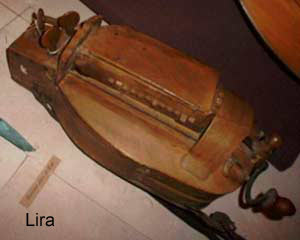
Contrary to most European hurdy-gurdy forms, the
Ukrainian lira has never had a trompette (drone string with rhythmical function). It is also noteworthy that quite a few players turn the crank in both directions (first
forwards and then backwards); when the direction is changed, the sound is briefly
interrupted. The tradition of the lirnyky (hurdy-gurdy players) has played a
particular role in the Ukrainian musical culture of the 18th and 19th centuries. All the
musicians who are still active today belong to the revival generation. Supposedly the
instrument was imported from France by the Ukrainian Cossacks of colonel Ivan Sirko, who
took part in The Thirty Years War (1618-1648).
Okaryna - pottery or clay flute.
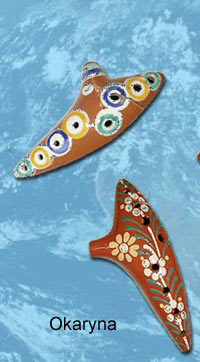
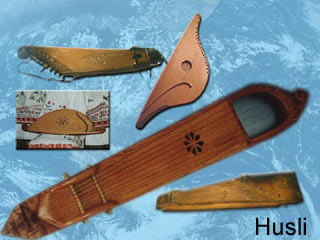
Tsymbaly - hammered dulcimer without legs. It is played
while sitting, held on the lap, or standing upright with the tsymbaly in front of the
stomach and held in position with the help of a belt around the neck of the player.
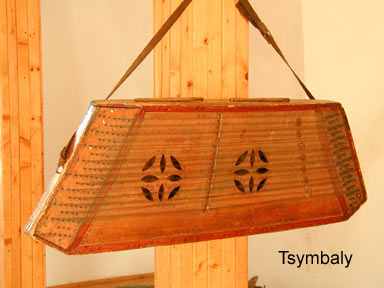
Skrypka (fiddle) - violin
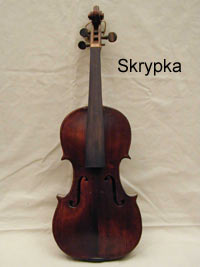
The fiddle tradition is dying out now, but there are
indications that the level of playing used to be very high, with remarkably strong bowing.
The tunes are played in the first position, but the compass is sometimes extended on the E
string with a glissando by the 2nd or 3rd finger. Some fiddlers produce an archaic vibrato
with these two fingers. Like the classical violin the skrypka is tuned in fifths
and roughly in concert pitch, even when it is played solo.

Sopilka (duct flute) - a wooden
end-blown flute. Sopilkas of various length and tuning exist. The instrument usually is
between 20 and 30 centimeters long and has 6 finger-holes.
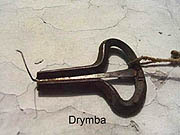 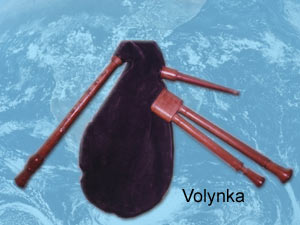 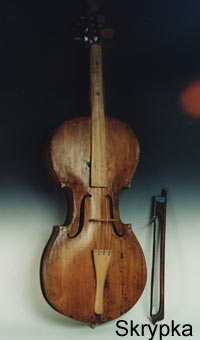
Language
Ukrainian is one of the three east-Slavonic languages. It
differs from Russian and Byelorussian as Spanish differs from Italian.
The most characteristic sounds in the Ukrainian language are:
1. The three i's.
a) The
i
which sounds more or less like ee in 'see', or like ea in 'eat’.
b) The
è
which souns like i in 'it', but with a raised middle of the
tongue.
c) The
¿
sounds like yie in 'yield'.
2. The two e's.
a)
e
sounding like e in 'ten'.
b)
ç
inversed(e) sounding like ye in 'yes'.
3. The h sound, which exists in the Ukrainian language. On the other hand, the
Ukrainian language doesn't have the sound g, like in 'good'.
Some of the songs are sung in a Ukrainian dialect, and some in a border dialect that
inclines towards Russian language.

START |